Digitalization for Fast, Fair, and Safe Humanitarian Logistics
Abstract
:1. Introduction
2. Literature Review
2.1. Humanitarian Logistics
2.2. Digitalization
3. Research Model and Hypothesis Development
3.1. Digitalization and Accountability
3.2. Digitalization and Security
3.3. Digitalization and Trust
3.4. Digitalization and Transparency
3.5. Digitalization and Promptness
4. Research Design and Methodology
Sample and Data Collection
5. Results and Analysis
5.1. Evaluation of the Measurement Model
5.1.1. Endogenous Variables
5.1.2. The Measurement Model’s Reliability
5.1.3. The Model’s Validity
5.2. Hypothesis Testing
6. Discussion, Practical Implications, and Limitations
7. Conclusions
Author Contributions
Funding
Institutional Review Board Statement
Informed Consent Statement
Data Availability Statement
Conflicts of Interest
Appendix A
| S/No | Constructs and Items | References |
| Accountability | ||
| 1 | Digitalization brings accountability for my target’s achievements. (ACC1) | [3,4] |
| 2 | Through digitalization, I must get a positive or negative reward for the success or failure of my target achievement. (ACC2) | |
| 3 | Due to digitalization, I must develop myself professionally in order to accomplish my work in the best possible way. (ACC3) | |
| 4 | During humanitarian logistics, I am responsible for proper relief distribution using digitalization in the best possible way. (ACC4) | |
| 5 | We routinely use digitalization as a data platform that traces the origins, use, and destination of humanitarian supplies. (ACC5) | |
| 6 | Due to digitalization, the aid materials are always properly managed. (ACC6) | |
| Security | ||
| 1 | My personal information is treated confidentially. (SEC1) | [3,4,61] |
| 2 | I feel secure supplying relevant information when using the technology of my organization. (SEC2) | |
| 3 | I feel safe in my transactions with the organization’s technology. (SEC3) | |
| 4 | A clear privacy policy is stated when I use the organization’s technology. (SEC4) | |
| 5 | We use digitalization as it helps to maintain confidentiality and integrity of the data. (SEC5) | |
| 6 | Digitalization is to avoid sharing unreliable information and confusion among partners engaged in disaster relief operations. (SEC6) | |
| Trust | ||
| 1 | The firm providing the digitalization is well known. (TRU1) | [3,4] |
| 2 | The firm providing the digitalization has a good reputation. (TRU2) | |
| 3 | The organization’s digitalization understands the victims’ specific needs. (TRU3) | |
| 4 | I trust in my organization’s humanitarian logistic activities through digitalization in the relief operation. (TRU4) | |
| 5 | Digitalization enables my organization to provide sincere aid to our stakeholders. (TRU5) | |
| 6 | We have no reason to doubt employees’ competence and preparations for tasks due to digitalization. (TRU6) | |
| Transparency | ||
| 1 | Digitalization enables my organization to routinely share our operational plans (i.e. distribution and storage plans). (TRN1) | [3,4] |
| 2 | Digitalization empowers us to share strategic information related to relief materials. (TRN2) | |
| 3 | Digitalization is the way to release information regarding humanitarian logistics that is current for stakeholders. (TRN3) | |
| 4 | Digitalization discloses the entire humanitarian logistics process accurately & transparently. (TRN4) | |
| 5 | I agree that digitalization developed clarity and accuracy of information to the stakeholders. (TRN5) | |
| Promptness | ||
| 1 | I can get the service done with the organization in a short time. (PRMP 1) | [61] |
| 2 | My organization responds to disaster quickly due to the digitalization. (PRMP 2) | |
| 3 | The organization’s digitalization provides real-time comprehensive information needed to distribute aid quickly. (PRMP 3) | |
| 4 | Digitalization of the organization is simple and easy to understand and requires little effort. (PRMP 4) | |
| 5 | Each service item/function of the digitalization is error-free. (PRMP 5) | |
| Digitalization | ||
| 1 | Digitalization is good for assurance, control, and continuous improvement during disaster relief operations. (DIG1) | [4,61,62] |
| 2 | My organization utilizes digitalization to create and store information for accountability. (DIG2) | |
| 3 | My organization utilizes digitalization for management of relief materials. (DIG3) | |
| 4 | I feel safe in my information sharing with the organization’s digitalization. (DIG4) | |
| 5 | In my opinion, humans make more errors than computers. (DIG5) | |
| 6 | Digitalization is to prevent errors; it helps to maintain confidentiality. (DIG6) | |
| 7 | We use digitalization as it helps to maintain integrity and availability of the data. (DIG7) | |
| 8 | We routinely use digitalization to avoid unreliable information and to avoid confusion among partners engaged in disaster relief operations. (DIG8) | |
| 9 | Digitalization can deal with personal data more carefully than human to improve transparency in disaster relief operations. (DIG9) | |
| 10 | My organization uses the digitalization for the disclosure of meeting humanitarian logistics effectiveness. (DIG10) | |
| 11 | We use digitalization to improve transparency in disaster relief supply chains. (DIG11) | |
| 12 | We routinely use digitalization as a data platform that traces the origins, use, and destination of humanitarian supplies. (DIG12) | |
| 13 | I agree with the development of my organization’s speed to save lives and decrease human suffering through digitalization. (DIG13) | |
| 14 | Digitalization of my organization is a platform for fast, fair, and safe humanitarian logistics. (DIG14) | |
References
- Raschky, P.; Chantarat, S. Natural Disaster Risk Financing and Transfer in ASEAN Countries. In Oxford Research Encyclopedia of Natural Hazard Science; Oxford University Press: New York, NY, USA, 2020. [Google Scholar]
- Khan, M.; Yong, L.H.; Han, B.J. A Systematic Review of Performance Enhancement of Humanitarian Logistics through Transparency: Current Status and Perspectives. Int. J. Sup. Chain. Mgt. Vol. 2019, 8, 549. [Google Scholar]
- Khan, M.; Lee, H.Y.; Bae, J.H. The Role of Transparency in Humanitarian Logistics. Sustainability 2019, 11, 2078. [Google Scholar] [CrossRef] [Green Version]
- Khan, M.; Imtiaz, S.; Parvaiz, G.S.; Hussain, A.; Bae, J. Integration of Internet-of-Things With Blockchain Technology to Enhance Humanitarian Logistics Performance. IEEE Access 2021, 9, 25422–25436. [Google Scholar] [CrossRef]
- Iqbal, T.; Ahmad, S. Transparency in humanitarian logistics and supply chain: The moderating role of digitalisation. J. Humanit. Logist. Supply Chain. Manag. 2022. [Google Scholar] [CrossRef]
- Cohen, L.; Salaun, V. E-Cash & E-Vouchers: The digitalization of the humanitarian aid and logistics. In Digitalization in Supply Chain Management and Logistics: Smart and Digital Solutions for an Industry 4.0 Environment, Proceedings of the Hamburg International Conference of Logistics (HICL), Hamburg, Germany, 23–24 September 2021; Epubli GmbH: Berlin, Germany, 2017; Volume 23, pp. 157–174. [Google Scholar]
- Kersten, W.; Blecker, T.; Ringle, C.M. Digitalization in Supply Chain Management and Logistics: Smart and Digital Solutions for an Industry 4.0 Environment; Epubli GmbH: Berlin, Germany, 2017. [Google Scholar]
- Rodríguez-Espíndola, O.; Chowdhury, S.; Beltagui, A.; Albores, P. The potential of emergent disruptive technologies for humanitarian supply chains: The integration of blockchain, Artificial Intelligence and 3D printing. Int. J. Prod. Res. 2020, 58, 4610–4630. [Google Scholar] [CrossRef]
- Quarshie, A.M.; Salmi, A.; Leuschner, R. Sustainability and corporate social responsibility in supply chains: The state of research in supply chain management and business ethics journals. J. Purch. Supply Manag. 2016, 22, 82–97. [Google Scholar] [CrossRef]
- Caon, M.; Khaled, O.A.; Vaucher, P.; Mezher, D.; Mc Guire, G. Digitalization of the last mile of a humanitarian supply chain. In International Conference on Human Interaction and Emerging Technologies; Springer: Cham, Switzerland, 2020. [Google Scholar]
- Fallucchi, F.; Tarquini, M.; De Luca, E.W. Supporting humanitarian logistics with intelligent applications for disaster management. Intelli 2016, 64, 2016. [Google Scholar]
- Thomas, A.S.; Kopczak, L.R. From logistics to supply chain management: The path forward in the humanitarian sector. Fritz Inst. 2005, 15, 1–15. [Google Scholar]
- Everett, J.; Friesen, C. Humanitarian accountability and performance in the Théâtre de l’Absurde. Crit. Perspect. Account. 2010, 21, 468–485. [Google Scholar] [CrossRef]
- Pérez-Galarce, F.; Canales, L.J.; Vergara, C.; Candia-Véjar, A. An optimization model for the location of disaster refuges. Socio-Econ. Plan. Sci. 2017, 59, 56–66. [Google Scholar] [CrossRef]
- Maon, F.; Lindgreen, A.; Vanhamme, J. Developing supply chains in disaster relief operations through cross-sector socially oriented collaborations: A theoretical model. Supply Chain. Manag. Int. J. 2009, 14, 149–164. [Google Scholar] [CrossRef]
- Kabra, G.; Ramesh, A. Information technology, mutual trust, flexibility, agility, adaptability: Understanding their linkages and impact on humanitarian supply chain management performance. Risk Hazards Crisis Public Policy 2016, 7, 79–103. [Google Scholar] [CrossRef]
- Zaw, T.N.; Lim, S. The military’s role in disaster management and response during the 2015 Myanmar floods: A social network approach. Int. J. Disaster Risk Reduct. 2017, 25, 1–21. [Google Scholar] [CrossRef]
- Apte, A.; Gonçalves, P.; Yoho, K. Capabilities and competencies in humanitarian operations. J. Humanit. Logist. Supply Chain. Manag. 2016, 6, 240–258. [Google Scholar] [CrossRef]
- Anjomshoae, A.; Hassan, A.; Kunz, N.; Wong, K.Y.; de Leeuw, S. Toward a dynamic balanced scorecard model for humanitarian relief organizations’ performance management. J. Humanit. Logist. Supply Chain. Manag. 2017, 7, 194–218. [Google Scholar] [CrossRef]
- Larrea, O. Key performance indicators in humanitarian logistics in Colombia. IFAC Proc. Vol. 2013, 46, 211–216. [Google Scholar] [CrossRef]
- Khan, M.; Yong, L.H.; Han, B.J. Emerging Techniques for Enhancing the Performance of Humanitarian Logistics. Int. J. Sup. Chain. Mgt. Vol. 2019, 8, 450. [Google Scholar]
- Aranda, D.A.; Fernández, L.M.M.; Stantchev, V. Integration of Internet of Things (IoT) and Blockchain to increase humanitarian aid supply chains performance. In Proceedings of the 2019 5th International Conference on Transportation Information and Safety (ICTIS), Liverpool, UK, 14–17 July 2019; pp. 140–145. [Google Scholar]
- Anjomshoae, A.; Banomyong, R.; Mohammed, F.; Kunz, N. A systematic review of humanitarian supply chains performance measurement literature from 2007 to 2021. Int. J. Disaster Risk Reduct. 2022, 72, 102852. [Google Scholar] [CrossRef]
- Yin, C.; Liu, P. Optimization of Emergency Logistics Service Capacity in the Context of COVID-19. For. Chem. Rev. 2022, 1427–1439. [Google Scholar]
- Rabta, B.; Wankmüller, C.; Reiner, G. A drone fleet model for last-mile distribution in disaster relief operations. Int. J. Disaster Risk Reduct. 2018, 28, 107–112. [Google Scholar] [CrossRef]
- Maxwell, D.; Walker, P.; Church, C.; Harvey, P.; Savage, K.; Bailey, S.; Hees, R.; Ahlendorf, M.-L. Preventing Corruption in Humanitarian Assistance; Transparency International/Feinstein International Center Research Report; Feinstein International Center: Berlin, Germany, 2008. [Google Scholar]
- Eslami, M.H.; Jafari, H.; Achtenhagen, L.; Carlbäck, J.; Wong, A. Financial performance and supply chain dynamic capabilities: The Moderating Role of Industry 4.0 technologies. Int. J. Prod. Res. 2021, 1–18. [Google Scholar] [CrossRef]
- Roy, P.; Albores, P.; Brewster, C. Logistical framework for last mile relief distribution in humanitarian supply chains: Considerations from the field. In Proceedings of the International Conference on Manufacturing Research, Lisbon, Portugal, 17–19 October 2012; pp. 11–13. [Google Scholar]
- Cheema, A.R.; Mehmood, A.; Imran, M. Learning from the past: Analysis of disaster management structures, policies and institutions in Pakistan. Disaster Prev. Manag. 2016, 25, 449–463. [Google Scholar] [CrossRef]
- Kunz, N.; Gold, S. Sustainable humanitarian supply chain management–Exploring new theory. Int. J. Logist. Res. Appl. 2017, 20, 85–104. [Google Scholar] [CrossRef]
- Holguín-Veras, J.; Jaller, M.; Van Wassenhove, L.N.; Pérez, N.; Wachtendorf, T. On the unique features of post-disaster humanitarian logistics. J. Oper. Manag. 2012, 30, 494–506. [Google Scholar] [CrossRef]
- Westlund, S. The use of geospatial technology in disaster management. In Geospatial Technologies and Advancing Geographic Decision Making: Issues and Trends; IGI Global: Hershey, PA, USA, 2012; pp. 21–34. [Google Scholar]
- Khan, M.; Sarmad, M.; Shah, S.F.A.; Han, B.J. Extent of Employee Turnover in Humanitarian Logistics: An Interpretive Structural Modelling Approach. Int. J. Sup. Chain. Mgt. Vol. 2020, 9, 107. [Google Scholar]
- Prusty, A.R.; Mohanty, A. Prospect of Low Power Sensor Network Technology in Disaster Management for Sustainable Future. In Emergency and Disaster Management: Concepts, Methodologies, Tools, and Applications; IGI Global: Hershey, PA, USA, 2019; pp. 834–856. [Google Scholar]
- Alom, M.M. Proactive transparency and outward accountability of frontline public bureaucracies: An integrated model. Int. J. Product. Perform. Manag. 2018, 67, 611–628. [Google Scholar] [CrossRef]
- Jarvis, M.D. The black box of bureaucracy: Interrogating accountability in the public service. Aust. J. Public Adm. 2014, 73, 450–466. [Google Scholar] [CrossRef]
- Rawlins, B.R. Measuring the Relationship between Organizational Transparency and Employee Trust. Public Relat. J. 2008, 2, 1–21. [Google Scholar]
- Bracci, E. Accountability and governance in social care: The impact of personalisation. Qual. Res. Account. Manag. 2014, 11, 111–128. [Google Scholar] [CrossRef]
- Dellaportas, S.; Langton, J.; West, B. Governance and accountability in Australian charitable organisations: Perceptions from CFOs. Int. J. Account. Inf. Manag. 2012, 20, 238–254. [Google Scholar] [CrossRef]
- Gould, J.E.; Macharis, C.; Haasis, H.-D. Emergence of security in supply chain management literature. J. Transp. Secur. 2010, 3, 287–302. [Google Scholar] [CrossRef]
- Casey, M.J.; Wong, P. Global supply chains are about to get better, thanks to blockchain. Harv. Bus. Rev. 2017, 13, 1–6. [Google Scholar]
- Dubey, R.; Gunasekaran, A.; Bryde, D.J.; Dwivedi, Y.K.; Papadopoulos, T. Blockchain technology for enhancing swift-trust, collaboration and resilience within a humanitarian supply chain setting. Int. J. Prod. Res. 2020, 11, 1–18. [Google Scholar] [CrossRef]
- Park, H.; Blenkinsopp, J. The roles of transparency and trust in the relationship between corruption and citizen satisfaction. Int. Rev. Adm. Sci. 2011, 77, 254–274. [Google Scholar] [CrossRef] [Green Version]
- Ganesan, S.; Hess, R. Dimensions and levels of trust: Implications for commitment to a relationship. Mark. Lett. 1997, 8, 439–448. [Google Scholar] [CrossRef]
- Lu, Q.; Goh, M.; de Souza, R. An Empirical Investigation of Swift Trust in Humanitarian Logistics Operations. In The Palgrave Handbook of Humanitarian Logistics and Supply Chain Management; Springer: Cham, Switzerland, 2018; pp. 279–296. [Google Scholar]
- Schweitzer, M.E.; Hershey, J.C.; Bradlow, E.T. Promises and lies: Restoring violated trust. Organ. Behav. Hum. Decis. Processes 2006, 101, 1–19. [Google Scholar] [CrossRef] [Green Version]
- De Fine Licht, J. Do we really want to know? The potentially negative effect of transparency in decision making on perceived legitimacy. Scand. Political Stud. 2011, 34, 183–201. [Google Scholar] [CrossRef] [Green Version]
- Huang, M.; Smilowitz, K.; Balcik, B. Models for relief routing: Equity, efficiency and efficacy. Transp. Res. Part E Logist. Transp. Rev. 2012, 48, 2–18. [Google Scholar] [CrossRef]
- Parris, D.L.; Dapko, J.L.; Arnold, R.W.; Arnold, D. Exploring transparency: A new framework for responsible business management. Manag. Decis. 2016, 54, 222–247. [Google Scholar] [CrossRef]
- Altay, N.; Labonte, M. Challenges in humanitarian information management and exchange: Evidence from Haiti. Disasters 2014, 38, S50–S72. [Google Scholar] [CrossRef]
- Men, L.R. Internal reputation management: The impact of authentic leadership and transparent communication. Corp. Reput. Rev. 2014, 17, 254–272. [Google Scholar] [CrossRef]
- Najib Razali, M.; Mohd Adnan, Y. Transparency in Malaysian property companies. Prop. Manag. 2012, 30, 398–415. [Google Scholar] [CrossRef]
- Nurmala, N.; Nurmala, N.; de Leeuw, S.; de Leeuw, S.; Dullaert, W.; Dullaert, W. Humanitarian–business partnerships in managing humanitarian logistics. Supply Chain Manag. Int. J. 2017, 22, 82–94. [Google Scholar] [CrossRef]
- Dube, N.; Van der Vaart, T.; Teunter, R.; Van Wassenhove, L. Host government impact on the logistics performance of international humanitarian organisations. J. Oper. Manag. 2016, 47, 44–57. [Google Scholar] [CrossRef] [Green Version]
- Kovács, G.; Spens, K.M. Humanitarian logistics in disaster relief operations. Int. J. Phys. Distrib. Logist. Manag. 2007, 37, 99–114. [Google Scholar] [CrossRef]
- Van Wassenhove, L.N. Humanitarian aid logistics: Supply chain management in high gear. J. Oper. Res. Soc. 2006, 57, 475–489. [Google Scholar] [CrossRef]
- Whiting, M.C.; Ayala-Öström, B.E. Advocacy to promote logistics in humanitarian aid. Manag. Res. News 2009, 32, 1081–1089. [Google Scholar] [CrossRef]
- Radianti, J.; Dokas, I.; Boersma, K.; Noori, N.S.; Belbachir, N.; Stieglitz, S. Enhancing disaster response for hazardous materials using emerging technologies: The role of AI and a research agenda. In Proceedings of the International Conference on Engineering Applications of Neural Networks, 20th International Conference, EANN 2019, Xersonisos, Crete, Greece, 24–26 May 2019; pp. 368–376. [Google Scholar]
- Bhat, S.A.; Bashir, M. Measuring ICT orientation: Scale development & validation. Educ. Inf. Technol. 2018, 23, 1123–1143. [Google Scholar]
- Hinkin, T.R. A brief tutorial on the development of measures for use in survey questionnaires. Organ. Res. Methods 1998, 1, 104–121. [Google Scholar] [CrossRef]
- Lin, J.-S.C.; Hsieh, P.-L. Assessing the self-service technology encounters: Development and validation of SSTQUAL scale. J. Retail. 2011, 87, 194–206. [Google Scholar] [CrossRef]
- Ongena, Y.P.; Haan, M.; Yakar, D.; Kwee, T.C. Patients’ views on the implementation of artificial intelligence in radiology: Development and validation of a standardized questionnaire. Eur. Radiol. 2020, 30, 1033–1040. [Google Scholar] [CrossRef] [PubMed] [Green Version]
- Hair, J.F., Jr.; Matthews, L.M.; Matthews, R.L.; Sarstedt, M. PLS-SEM or CB-SEM: Updated guidelines on which method to use. Int. J. Multivar. Data Anal. 2017, 1, 107–123. [Google Scholar] [CrossRef]
- Armstrong, J.S.; Overton, T.S. Estimating nonresponse bias in mail surveys. J. Mark. Res. 1977, 14, 396–402. [Google Scholar] [CrossRef] [Green Version]
- Garson, G.D. Partial Least Squares: Regression and Structural Equation Models; Statistical Associates Publishers: Asheboro, NC, USA, 2016. [Google Scholar]
- Hair, J.F.; Risher, J.J.; Sarstedt, M.; Ringle, C.M. When to use and how to report the results of PLS-SEM. Eur. Bus. Rev. 2019, 31. [Google Scholar] [CrossRef]
- George, D. SPSS for Windows Step by Step: A Simple Study Guide and Reference, 17.0 Update, 10/e; Pearson Education India: Delhi, India, 2011. [Google Scholar]
- Neter, J.; Wasserman, W.; Kutner, M.H. Applied Regression Models; Rich-ard D. Irwin, Inc.: Homewood, IL, USA, 1983. [Google Scholar]
- Cfroteod, C. CRED Crunch 58—Disaster. In Year in Review; CRED: Brussels, Belgium, 2020; p. 58. [Google Scholar]
- Cohen, J. Statistical Power Analysis for the Behavioral Sciences, 2nd ed.; Erlbaum Associates: Hillsdale, NJ, USA, 1988. [Google Scholar]
- Hair, J.F.; Black, W.C.; Babin, B.J.; Anderson, R.E.; Tatham, R.L. Análise multivariada de dados; Bookman Editora: Porto Alegre, Brazil, 2009. [Google Scholar]
- Neuman, S.P. Generalized scaling of permeabilities: Validation and effect of support scale. Geophys. Res. Lett. 1994, 21, 349–352. [Google Scholar] [CrossRef] [Green Version]
- Fornell, C.; Larcker, D.F. Evaluating structural equation models with unobservable variables and measurement error. J. Mark. Res. 1981, 18, 39–50. [Google Scholar] [CrossRef]
- Voorhees, C.M.; Brady, M.K.; Calantone, R.; Ramirez, E. Discriminant validity testing in marketing: An analysis, causes for concern, and proposed remedies. J. Acad. Mark. Sci. 2016, 44, 119–134. [Google Scholar] [CrossRef]
- Henseler, J.; Ringle, C.M.; Sarstedt, M. A new criterion for assessing discriminant validity in variance-based structural equation modeling. J. Acad. Mark. Sci. 2015, 43, 115–135. [Google Scholar] [CrossRef] [Green Version]
- Khan, M.; Hussain, A.; Farooq, N.; Sahibzada, S.; Khattak, A.; Malik, S. Applying Interpretive Structural Modeling and MICMAC Analysis to Evaluate Inhibitors to Transparency in Humanitarian Logistics. UtopÍA Y Prax. Latinoam. 2020, 25, 325–337. [Google Scholar]
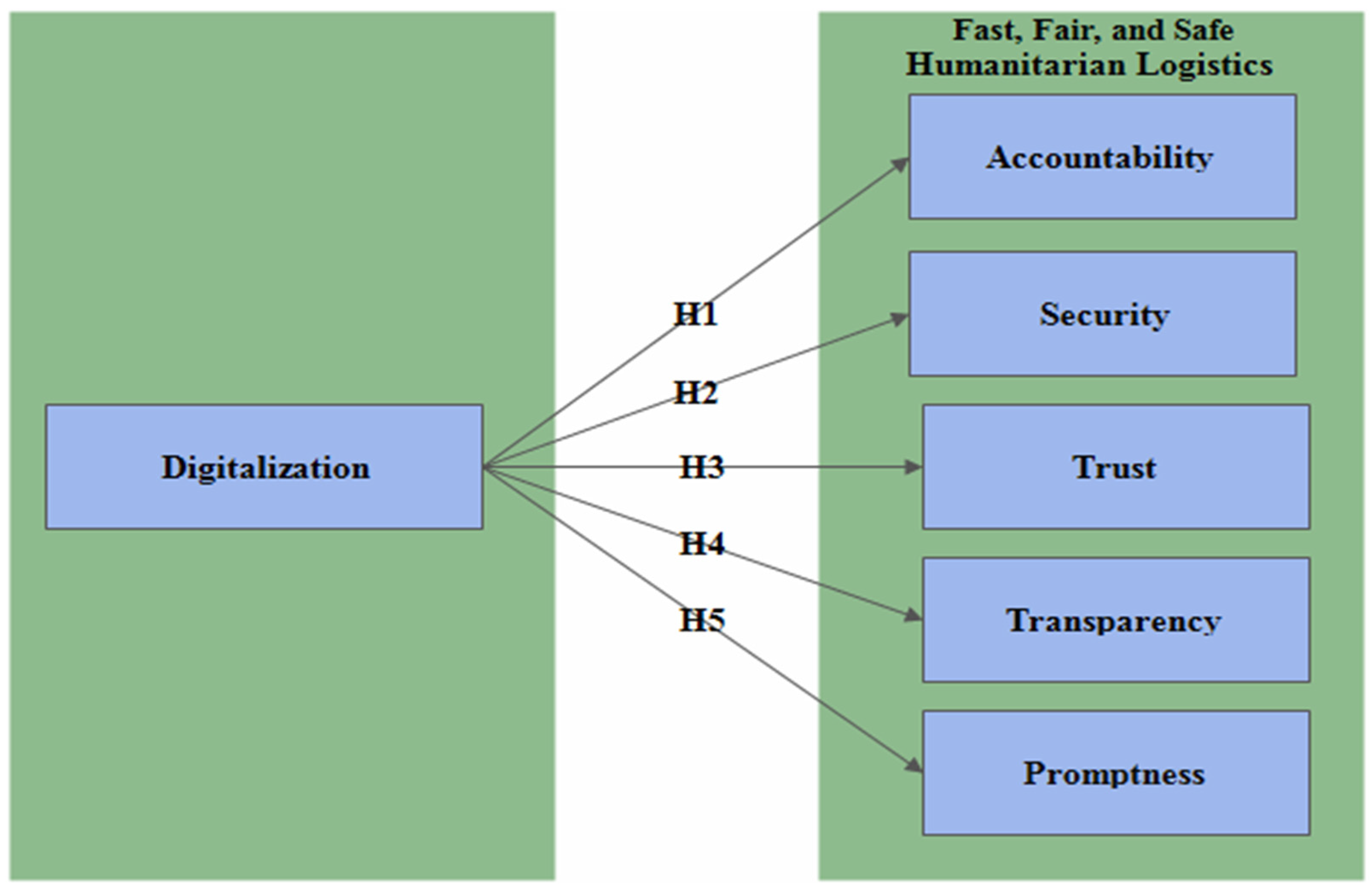
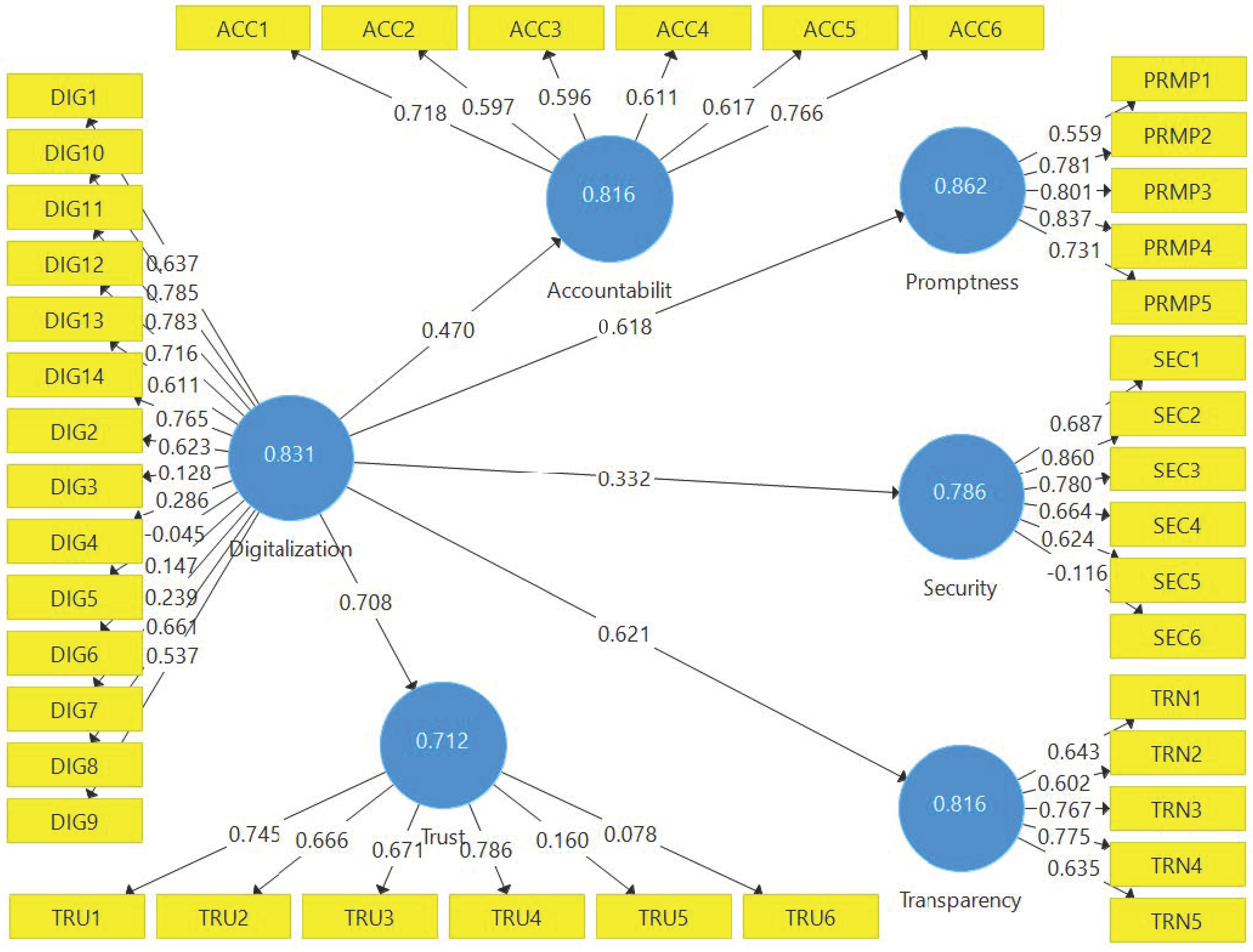
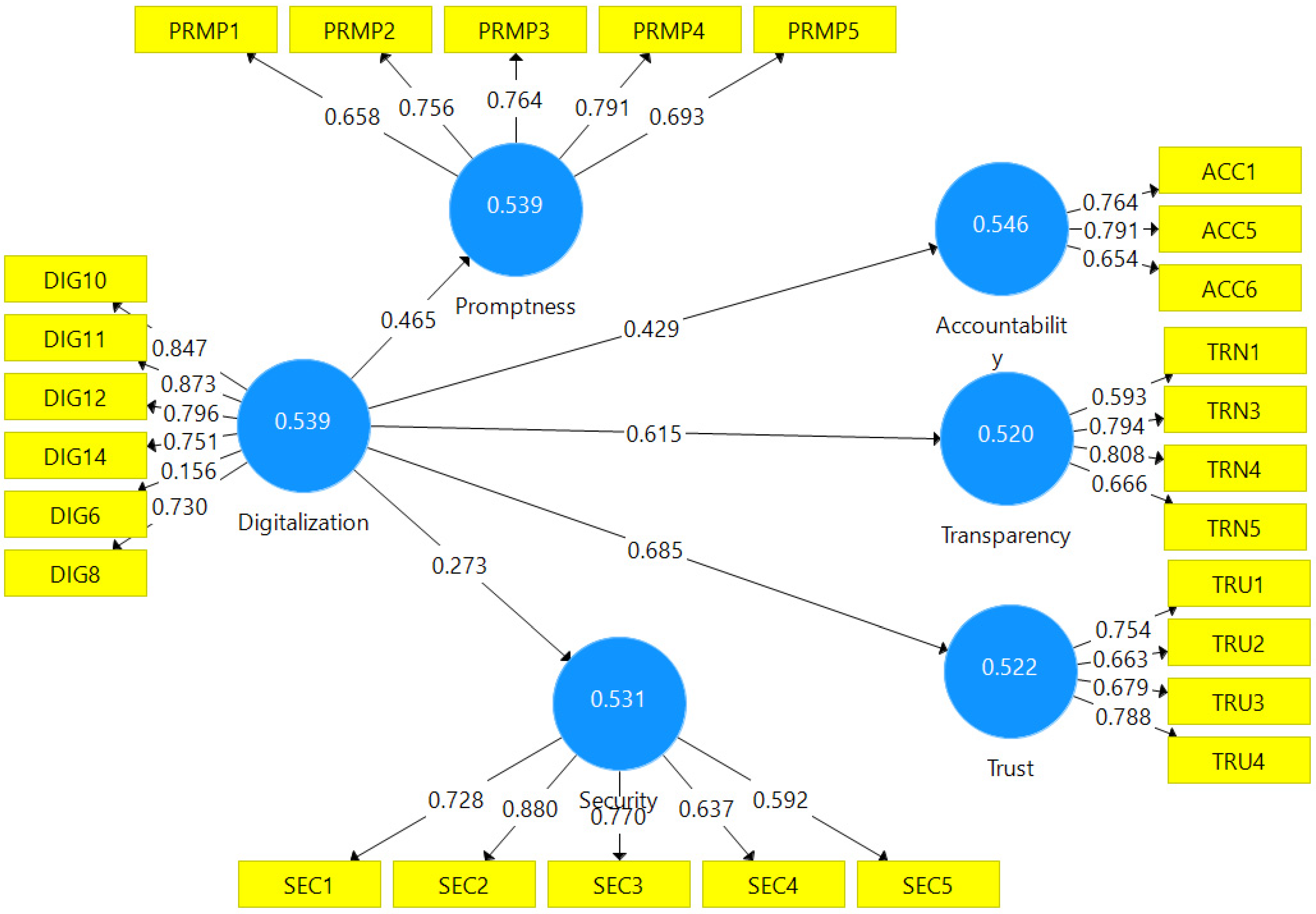
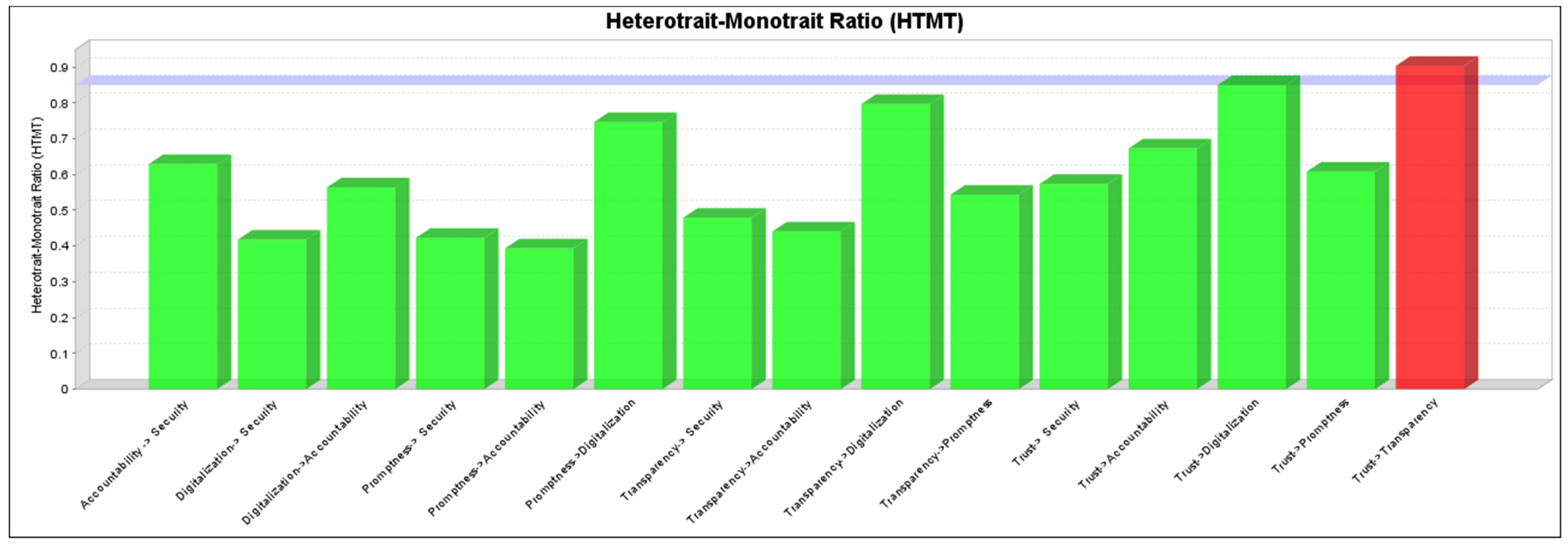
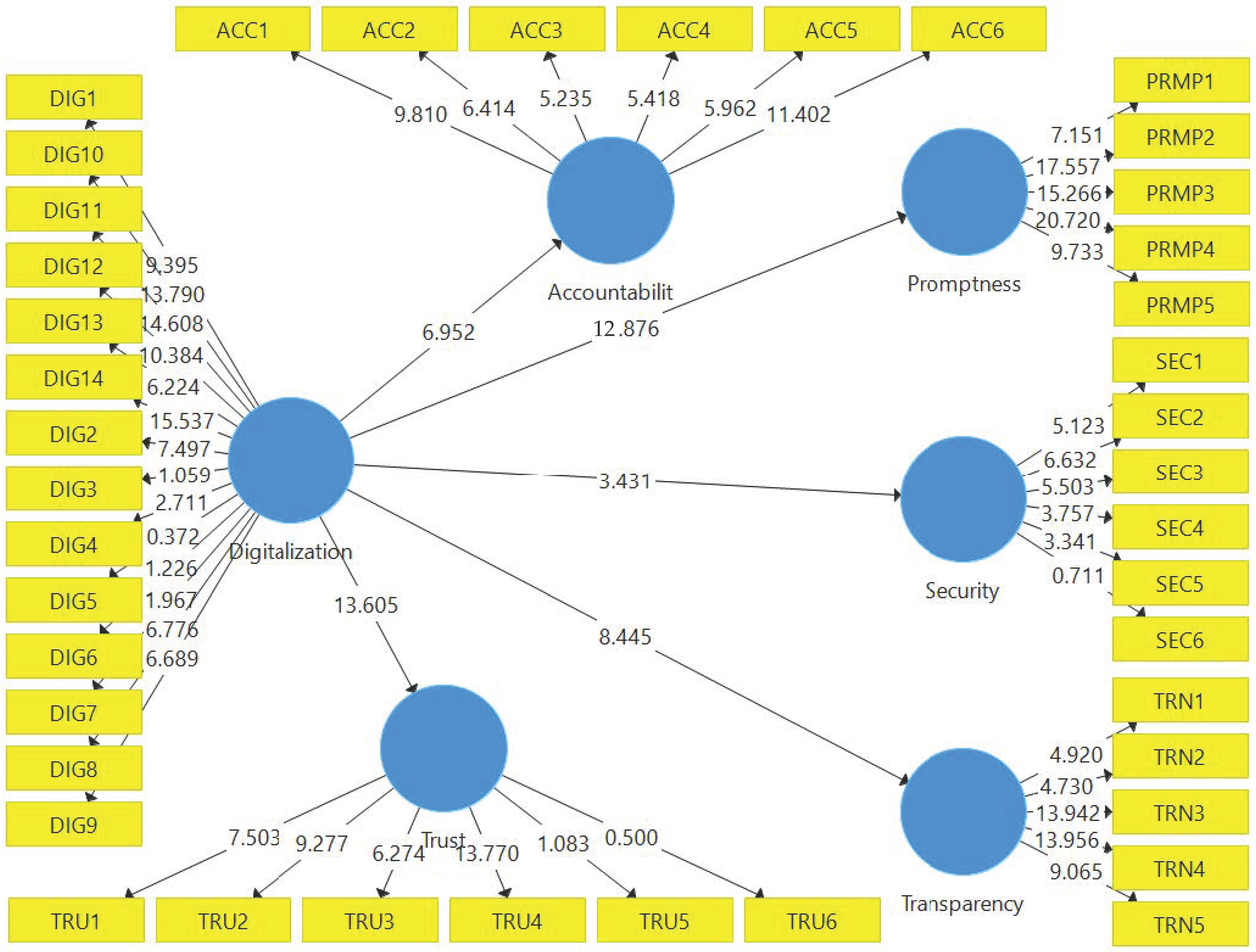
| Accountability | Security | Trust | Transparency | Promptness | Digitalization | ||
|---|---|---|---|---|---|---|---|
| N | Valid | 449 | 449 | 449 | 449 | 449 | 449 |
| Missing | 0 | 0 | 0 | 0 | 0 | 0 | |
| Mean | 3.352 | 4.016 | 4.140 | 4.116 | 3.954 | 4.234 | |
| Median | 3.300 | 4.000 | 4.200 | 4.200 | 4.000 | 4.300 | |
| Mode | 3.0 | 4.0 | 4.5 | 5.0 | 4.0 | 4.4 | |
| Std. Deviation | 0.8542 | 0.4970 | 0.5488 | 0.7181 | 0.6678 | 0.4105 | |
| Variance | 0.730 | 0.247 | 0.301 | 0.516 | 0.446 | 0.169 | |
| Skewness | −0.057 | −0.164 | −0.582 | −0.449 | −0.328 | −0.902 | |
| Std. Error of Skewness | 0.241 | 0.241 | 0.241 | 0.241 | 0.241 | 0.241 | |
| Kurtosis | −0.467 | −0.088 | 0.055 | −0.763 | −0.300 | 0.861 | |
| Std. Error of Kurtosis | 0.478 | 0.478 | 0.478 | 0.478 | 0.478 | 0.478 | |
| VIF | 1.610 | 1.800 | 1.352 | 1.523 | 1.900 | 1.950 | |
| R Square | Adjusted R Square | Cronbach’s Alpha | Composite Reliability | Average Variance Extracted | |
|---|---|---|---|---|---|
| Digitalization | 0.777 | 0.831 | 0.539 | ||
| Accountability | 0.221 | 0.213 | 0.744 | 0.816 | 0.546 |
| Security | 0.110 | 0.101 | 0.779 | 0.786 | 0.531 |
| Trust | 0.501 | 0.496 | 0.704 | 0.712 | 0.522 |
| Transparency | 0.386 | 0.380 | 0.722 | 0.816 | 0.520 |
| Promptness | 0.382 | 0.376 | 0.798 | 0.862 | 0.539 |
| Accountability | Security | Trust | Transparency | Promptness | Digitalization | |
|---|---|---|---|---|---|---|
| Accountability | 1 | |||||
| Security | 0.459 ** | 1 | ||||
| Trust | 0.481 ** | 0.366 ** | 1 | |||
| Transparency | 0.310 ** | 0.319 ** | 0.582 ** | 1 | ||
| Promptness | 0.294 ** | 0.248 * | 0.435 ** | 0.423 ** | 1 | |
| Digitalization | 0.392 ** | 0.239 * | 0.544 ** | 0.586 ** | 0.578 ** | 1 |
| Path Coefficient | Sample Mean | Std. Deviation | T Statistics | P Values | Supported? | |
|---|---|---|---|---|---|---|
| Digitalization → Accountability (H1) | 0.470 | 0.501 | 0.068 | 6.952 | 0.000 | Yes |
| Digitalization → Security (H2) | 0.332 | 0.371 | 0.091 | 3.431 | 0.001 | Yes |
| Digitalization → Trust (H3) | 0.708 | 0.724 | 0.052 | 13.605 | 0.000 | Yes |
| Digitalization → Transparency (H4) | 0.621 | 0.634 | 0.079 | 8.445 | 0.000 | Yes |
| Digitalization → Promptness (H5) | 0.618 | 0.630 | 0.053 | 12.876 | 0.000 | Yes |
Publisher’s Note: MDPI stays neutral with regard to jurisdictional claims in published maps and institutional affiliations. |
© 2022 by the authors. Licensee MDPI, Basel, Switzerland. This article is an open access article distributed under the terms and conditions of the Creative Commons Attribution (CC BY) license (https://creativecommons.org/licenses/by/4.0/).
Share and Cite
Khan, M.; Khan, M.; Ali, A.; Khan, M.I.; Ullah, I.; Iqbal, M. Digitalization for Fast, Fair, and Safe Humanitarian Logistics. Logistics 2022, 6, 31. https://doi.org/10.3390/logistics6020031
Khan M, Khan M, Ali A, Khan MI, Ullah I, Iqbal M. Digitalization for Fast, Fair, and Safe Humanitarian Logistics. Logistics. 2022; 6(2):31. https://doi.org/10.3390/logistics6020031
Chicago/Turabian StyleKhan, Muhammad, Marwan Khan, Abbas Ali, Muhammad Imran Khan, Ihsan Ullah, and Muhammad Iqbal. 2022. "Digitalization for Fast, Fair, and Safe Humanitarian Logistics" Logistics 6, no. 2: 31. https://doi.org/10.3390/logistics6020031
APA StyleKhan, M., Khan, M., Ali, A., Khan, M. I., Ullah, I., & Iqbal, M. (2022). Digitalization for Fast, Fair, and Safe Humanitarian Logistics. Logistics, 6(2), 31. https://doi.org/10.3390/logistics6020031






